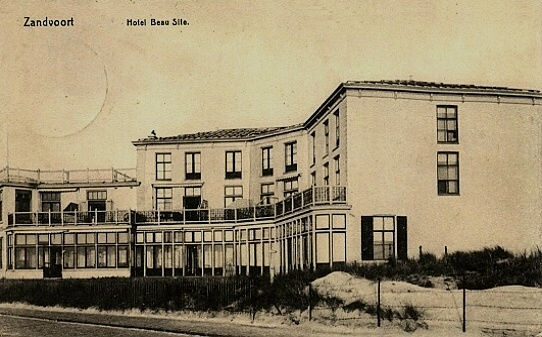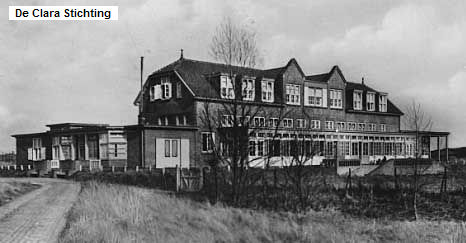The Jewish community of Zandvoort
Only during the second half of the 19th century can one talk of a Jewish existence in Zandvoort. Originally Jewish life consisted mainly of Jewish families from Amsterdam who spent some time in Zandvoort during the summer months. In the beginning of the 20th century some of these families moved into houses, which they had built, bought or rented and because of this a more organized Jewish life became necessary.
Among others synagogue services were started during the summer months at the beginning of the 20th century. As there did not exist yet a synagogue building, services were held in several halls, like for instance at a carpenter's workplace.
The necessity for a permanent place of worship became especially important after the First World War, and therefore a permanent solution was being sought.
The synagogue building
In 1918 the Jewish seaside visitors decided to establish a synagogue. Although already about 300 Jews lived permanently in Zandvoort, they had no intention of being active from a religious point of view. At a meeting of Jewish bathers on August 6th, 1919 it was decided to establish a society, which would keep track of the progress.At the second meeting, which was held a week later, chairman Veershym of the society in the process of formation, already announced that he had bought a plot on dr. Johan Metzger Street on which a villa could be built. The society, called Elia, was officially established on November 13th, 1919.
The upper story of the villa would serve as synagogue and it was the intention to rent it out partly or completely after the summer season, or it could be sold if not enough people were interested.
During the interim period one floor was rented for an improvised synagogue which was attended by 80 to 100 visitors each Shabbath during the bathing season. After the season, however, the Elia Association was not able to raise a minyan. This was one of the reasons why the Jewish community of Haarlem took over the care for the Zandvoort Jews on September 20th, 1920.
Because of a shortage of money, among others, the building of the villa had to be abandoned and on May 21, 1921 it was decided to build a simple synagogue on the plot on Dr. Johan Metzger Street. Its size was 7.5 by 10 meters and could hold 120 persons.
The corner stone was laid on June 22nd, 1922 in the presence of Mayor Beekman and the Rabbi of Haarlem, Rabbi S.Ph. de Vries. The Chief Rabbi of Amsterdam, A.S. Onderwijzer, performed the official opening on August 17th, 1922.
Jewish Education
The organization of Jewish education accounted for many problems. The Jews of Zandvoort were not interested and the Jewish Community of Haarlem requested the Permanent Commission of General Affairs of the Dutch Israelite Denomination (PC) to release them from their duties. No reply was received from the PC and therefore it was decided to appoint a commission, which would organize Jewish religious education.
The commission consisted of Messrs. J. Lissauer, N. Davids Bzn. and Rabbi de Vries.
End September 1922 a meeting was held in Hotel "Gompertz de Beer" by the Jewish inhabitants of Zandvoort on the subject of religious tuition for local Jewish youth.
It was decided to give the first lesson on October 22nd, 1922 and they appointed two teachers from Amsterdam for this purpose.
However, for the continuation a lot of money was needed which was not available. Although the commission had succeeded in attracting 25 students, this was not enough to cover the expenses. Their application for a subsidy from the PC and the Jewish Community in Amsterdam was supported by the Chief Rabbi of North Holland, A.S. Onderwijzer. But neither the PC nor the Jewish Community of Amsterdam were willing to cooperate. The PC stated that they only supported communities that were members of the NIK.
The Jewish community of Haarlem was prepared to give them a subsidy, as was Mr. Lissauer who gave them a subsidy from his own pocket.
The Jewish Community
The Jews from Zandvoort did not want Jewish tuition to disappear and they therefore organized a meeting on April 3rd, 1923 on the following subject: the establishment of an independent Jewish Community. 43 residents decided positively in spite of the financial problems, which were to be expected.
All this, however, did not go as easily as one might have expected. The NIK set forth the following conditions: -
- an interim budget
- a draft of the rules/regulations
- a program for the supply of the religious needs of the community members
- the demand to hold synagogue services
- the provision of Jewish tuition, as well as a religious bath and funerals
The community, however, was rather poor but this would improve during the thirties.
On September 12, 1923 the official inauguration took place at the Hotel d'Orange and on that occasion the chairman, Mr. Krouwer held a speech.
Mr. S. de Jong was appointed cantor and teacher. One and a half years later he was appointed cantor in Manchester. M. Frank Azn originating from Kampen was appointed in his place.
In 1927 the Jewish community in Zandvoort had 325 members from 90 families. Most of them were not religious and therefore attendance at synagogue services was small. Only during the bathing season was there enough interest. Jewish tuition was still dependent on subsidies of the Jewish community in Haarlem as well as on the visitors. These remained the most important sources of income. The financial problems were the reason for the resignation in 1930 of the treasurer, Mr. Anderson.
As from 1930 the situation of the community improved. In 1933 Mr. Spijer became chairman of the synagogue council. By the time he left in 1939 the community had claims instead of debts, which is why it could think of acquiring its own cemetery. This, however, could not be realized before the war.
The Clara Institution
The Clara Institution was opened in 1913 and its purpose was to care in Zandvoort, in a religious environment for Jewish children who suffered from tuberculosis. The foundation was made possible by a donation of 300,000 guilders from Michel Mendes, who at the time wished to remain anonymous. The name Clara was the name of the mother of this generous donor. Part of the amount would be used to cover yearly charges to the needy, so that children of impecunious parents could be admitted for free.
At the opening there was room for 24 children, which could later be extended to 35 children. If not all places were taken by Jewish children, non-Jewish children could also be admitted.
1933-1940
Because of the growing number of Jewish German citizens coming out of Germany, the German Jewish refugee committee was established. The Jewish community of Zandvoort also contributed. Their actions were limited mainly to the collection of money necessary to take care of the refugees.
Chairman of the committee in Zandvoort was the chairman of the Jewish community, Mr. Spijer. Many activities were organized like a fancy-fair, the sale of collected items, supper parties as well as a magnificently organized lottery.
Many wealthy persons, particularly among the visitors, voluntarily cooperated to collect – for that time – extremely high sums of money. Tens of thousands of guilders were collected for this purpose. (On the present basis, 2009, the amount should be multiplied by 22).
As a consequence of these activities alienation was ever more created between the Jewish and non-Jewish inhabitants of Zandvoort. Especially the non-Jewish youths who were often unemployed, turned against the Jews. Many skirmishes took place among the various youth movements/groups. At the national elections in 1935 the NSB, the Dutch Nazi party in Zandvoort received a high percentage of the votes: 23.35%, whereas the national average was 9.64%. Although Zandvoort's preference for the NSB abated somewhat, they still received 14.25% in 1937.
According to the analysts this choice was mainly determined by the increase of poverty in the thirties as well as the general state of the small agrarian communities, which became urbanized.
In consequence of this state of affairs the synagogue was blown up in 1940, not by the Germans but by Dutch Nazi's.
The economic structure of Zandvoort has always been weak, also because of its dependence on the (bathing) visitors. During the months of October till April not much could be done. Especially the economic crisis of the thirties was a catastrophe for Zandvoort. In 1935 Zandvoort had 600 unemployed. The average income in Zandvoort was lower than elsewhere in the dune areas of the provinces of North and South Holland.
The psychological climate
The many visitors caused a large split between the native inhabitants of Zandvoort and the visiting ones. The latter could afford to spend a lot more money and could therefore live a more luxurious life than the local inhabitants. Because many of the visitors were Jews from Amsterdam this was a cause for anti-semitism.
Well-known Amsterdam Jews
The following families, among others, had their own house or rented the same house every year for two to three months: -
Arn. Van Amerongen, diamond dealer
Dr. Jacobson, ear nose and throat specialist
A.Asscher, diamond dealer
Eduard Gerzon, owner of Gerzon's Fashion Houses
A.Cohen, owner of Maison de Bonneterie
A.Soep, diamond dealer
Alex Meyer, manager of Meyer Fabrics
Renee Kahn, owner of Fashion House Hirsch & Cie
A.Salomon, originating from St. Petersburg
B.van Leer, manufacturer of barrels
H.Nijker, metal factory Wiener & Co
M.Kattenburg, owner of rain wear factory
J.H. Lamon, banker
Dr. Sasson, scion of the wealthy Sassoon family
N.Streep, diamond dealer
Jewish Accomodation
Hotel de Favauge, blvd de Favauge
Hotel Hiegentlich, Kerkplein
Hotel Baue Site
Pensions Streep en Soester
Het Witte Huis (van Max Noach)
Well-known persons, citizens of Zandvoort
J. Bramson, Jewish SDAP (the Social Democratic Labour Party) member
A. Krouwer, chairman from 1923 till 1930
L.Anderson, treasurer from 1925 till 1930
S. de Jong, chazan and teacher
M. Frank, chazan and teacher
L.J. Elte, chairman in 1930
Z.L. Blok, member of the board
M. Spijer (m-??), chairman from 1933-1939
Well-known Jewish Shops
Rood en Vedder, pastry shop
Bloemendaal, butcher
Blitz en de Zwarte, grocery shop
De Jong, hairdressers
Bronkhorst en Pappie, cobbler and shoe shop
Dikker en Moscovier, textile shop
Van Overste, cigar shop
Wennik, greengrocer
Van Copsman, souvenir shop
Van Bohemen, photo shop
Jewish social life
There were two societies:
Bigdei Kodesj, chairwoman Mrs. Bloemendaal – purpose: to give a festive appearance to Jewish holidays and anniversaries.
And Wesomachto Begakego – purpose: social gatherings.
Source:
A.E. Spijer, "Zandvoorts wijzen kwamen uit het oosten"
Publisher Boekencentrum, Zoetermeer, 1995
ISBN 90 239 1479 1
with written consent of the publishers dated 19-11-2009
Edited by:Bob Engelsman and Ben Noach
Translated into English:Nina Mayer
Editorial Board, English:Trudi Asscher and Ben Noach
[an error occurred while processing this directive]
[an error occurred while processing this directive]
 |
 |
 |